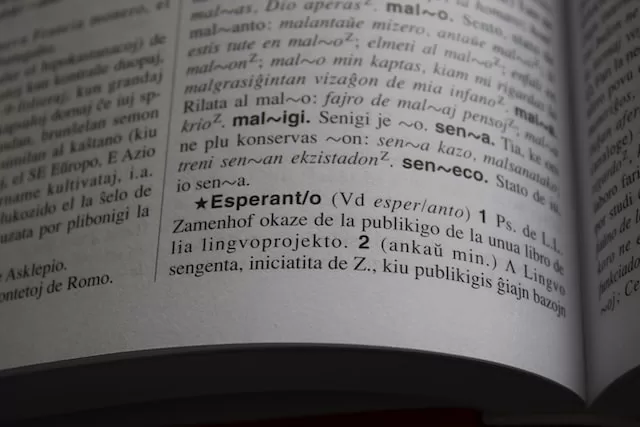What is Esperanto?
Esperanto is the oldest and most widely spoken of all the constructed languages, but it goes much farther than that.
You have arrived at the premier destination online for learning everything you need to know about Esperanto and its history, usage, and modern community.
We provide easy access to quality resources, merchandise, and insights into the language and its fascinating history.

What is Esperanto?
Esperanto is the oldest and most widely spoken of all the constructed languages, but it goes much farther than that.
You have arrived at the premier destination online for learning everything you need to know about Esperanto and its history, usage, and modern community.
We provide easy access to quality resources, merchandise, and insights into the language and its fascinating history.
Connect
Find resources, tools, and community to help you learn more about the language and connect with others.
Shop
Show your love for the language and culture (and help support this website) with our unique merchandise.
Learn
Everything you need to learn the basics of Esperanto through self-guided tools and private teachers.

Connect with other Esperanto speakers
Speakers of Esperanto (also called “Esperantists”) can be found all over the internet, if you know where to look. We can help you find other Esperantists so you can practice the language and make new friends.
Learn to speak Esperanto
Technically, we can define Esperanto as: “a constructed auxiliary language designed to promote communication among people from different linguistic backgrounds.” The language is so much more than that, however. Its simplicity and neutrality make it accessible to a wide range of individuals.
Whether you use online tools and teach yourself or partner with one of our many skilled teachers, we have all the tools you need to get started on your journey toward joining the community of millions of Esperanto speakers worldwide.


Already speak Esperanto?
Take our one-question poll and help us discover how many people actually speak Esperanto.
Shop for unique Esperanto clothing and products
Help support this website and show your love for Esperanto with our unique merchandise.
CHOOSE US
Why Learn With Us?
Various Esperanto Resources
Find communities, information, and teachers to help you on your journey.
Unique Esperanto Merchandise
Show your love for Esperanto and its culture by proudly showing off your unique Esperanto-themed merchandise not available anywhere else.
100% FREE!
This site is and always will be free to use, so anyone can find what they need within the Esperanto community. While some of the resources may be paid, it will always be free to find them.
Top Shelf Educators
We provide referrals to only the best Esperanto instructors from around the world. If you find your teacher through us, you know you’ll find a good one.
Esperanto is easy to learn and easy to use, regardless of your native language.
Esperanto is spoken in over 120 countries, so it's easy to make new friends anywhere in the world.
Studies have demonstrated that Esperanto provides a straightforward and memorable way of grasping grammar, making it an obvious choice for language learners.
CHOOSE US
Why Learn With Us?
Various Esperanto Resources
Find communities, information, and teachers to help you on your journey.
Unique Esperanto Merchandise
Show your love for Esperanto and its culture by proudly showing off your unique Esperanto-themed merchandise not available anywhere else.
100% FREE!
This site is and always will be free to use, so anyone can find what they need within the Esperanto community. While some of the resources may be paid, it will always be free to find them.
Top Shelf Educators
We provide referrals to only the best Esperanto instructors from around the world. If you find your teacher through us, you know you’ll find a good one.
Esperanto is easy to learn and easy to use, regardless of your native language.
Esperanto is spoken in over 120 countries, so it's easy to make new friends anywhere in the world.
Studies have demonstrated that Esperanto provides a straightforward and memorable way of grasping grammar, making it an obvious choice for language learners.
Frequently Asked Questions
What is Esperanto?
Esperanto is a constructed international auxiliary language designed to promote communication among people from different linguistic backgrounds. It aims for simplicity and neutrality, making it accessible to a wide range of individuals.
Why was Esperanto created?
Esperanto was created by L. L. Zamenhof in the late 19th century with the intention of fostering international understanding and communication. Zamenhof believed that a neutral and easy-to-learn language could bridge linguistic barriers, promote harmony among diverse cultures, and serve as a means for people to communicate more effectively across borders.
How difficult is it to learn Esperanto compared to other languages?
Learning Esperanto is generally considered to be significantly easier and faster than learning most other languages. This is due to its simple grammar, consistent phonetic pronunciation, and regular linguistic structures.
Since Esperanto was designed to be straightforward and accessible, many learners find that they can achieve basic proficiency in a relatively short amount of time, often much quicker than with traditional languages.
Additionally, the supportive global Esperanto community, with its wealth of learning resources, can help you along your language journey.
Can learning Esperanto improve your language learning skills overall?
Yes, learning Esperanto can indeed enhance your language learning skills. Its logical and regular structure serves as a foundation for understanding linguistic concepts that apply to many languages.
Mastering Esperanto’s basics can boost your confidence in tackling other languages, as you’ll already be familiar with concepts like noun-adjective agreement, verb conjugations, and word formation. This can lead to more efficient learning and a deeper appreciation for the mechanics of language.
Additionally, the experience of learning a second language can help you better understand the challenges and strategies involved in language acquisition, which can be applied to your overall language learning journey.
What are some famous books or works written in Esperanto?
Esperanto has a rich literary tradition with notable works that span various genres. One of the most renowned books is “Gerda Malaperis!” by William Auld, a detective novel often recommended for learners.
Another classic is “La Hobito” (The Hobbit) by J.R.R. Tolkien, translated into Esperanto. The poetry of Kálmán Kalocsay and William Auld, as well as original works like “La Infana Raso” by William Auld, showcase the language’s creative potential.
Moreover, numerous translated works and original creations across different genres are available, offering a diverse range of reading options for those interested in exploring Esperanto literature.
How has the internet impacted the spread of Esperanto gobally?
The internet has played a pivotal role in advancing the global reach of Esperanto. Online platforms, social media, and websites have provided a virtual space for Esperanto speakers and learners to connect, share resources, and engage in conversations. Online courses, forums, and video tutorials make it easier for people from diverse backgrounds to access learning materials and practice the language. Additionally, the internet has facilitated international collaboration, enabling Esperanto speakers to collaborate on projects, publications, and cultural exchanges regardless of geographical distance. Overall, the internet has significantly accelerated the dissemination and growth of the Esperanto community worldwide.
Is Esperanto still relevant in today's multicultural world?
Absolutely, Esperanto remains relevant in today’s multicultural world. As a neutral and inclusive language, it continues to bridge communication gaps among people from various linguistic backgrounds.
It serves as a tool for fostering understanding, cross-cultural friendships, and international collaboration. In an era where global connections are increasingly important, Esperanto’s ease of learning and universal appeal make it a valuable means of communication.
While not replacing native languages, Esperanto complements them, offering a common ground for respectful and meaningful exchanges, emphasizing the value of diversity and unity in our interconnected world.
Are there any celebrities who speak Esperanto?
Yes, there have been several well-known individuals who have spoken Esperanto. William Shatner, the actor famous for his role as Captain Kirk in Star Trek, has expressed interest in Esperanto and even recorded a birthday message in the language. Additionally, the linguist and political activist Noam Chomsky has shown support for Esperanto as a tool for linguistic equality. While not mainstream, these examples highlight the diverse appeal and potential impact of Esperanto across different fields and communities.
What are the benefits of using Esperanto for international travel?
Using Esperanto for international travel or communication offers several benefits. Its simplified grammar and consistent rules make it easier to learn compared to many other languages. This can facilitate basic interactions and practical communication with people from different countries. Esperanto’s neutrality avoids favoring any specific culture, reducing potential misunderstandings or biases. Moreover, engaging with the global Esperanto community can provide you with unique connections and cultural insights, enhancing your travel experiences. Overall, Esperanto can be a valuable tool for building connections and navigating diverse linguistic landscapes during your travels.
Can learning Esperanto have benefits beyond language skills?
Yes, learning Esperanto can offer cognitive and academic benefits beyond language skills. Studies suggest that learning Esperanto can improve cognitive functions like memory, problem-solving, and multitasking. Additionally, the structured nature of Esperanto can enhance analytical thinking and logical reasoning. Learning a constructed language like Esperanto can also deepen your understanding of linguistic concepts, which can be valuable if you’re interested in linguistics or language-related fields. These cognitive advantages, combined with the potential for cultural enrichment and global connections, make learning Esperanto a rewarding endeavor with wide-ranging benefits.
